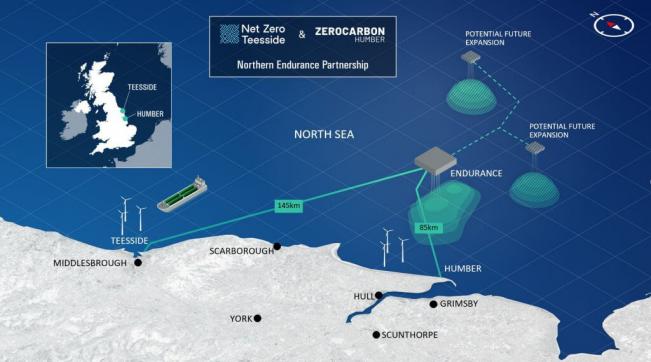
Carbon Capture, Utilisation and Storage (CCUS) projects are set to achieve greater prominence during 2021. At the forefront of these are two separate east coast carbon capture projects based in the heavyweight Humberside and Teesside industrial zones. The term CCUS represents process technologies that remove carbon dioxide emissions and store them deep underground to prevent them from being released into the atmosphere.
BP is leading the Northern Endurance Partnership (NEP), that includes Eni, Equinor, National Grid, Shell and Total, in a plan to transport 17m tonnes of carbon dioxide per annum from the two separate carbon capture projects. After decades spent extracting fossil fuels from the UK’s North Sea the consortium will pump Britain’s greenhouse gas emissions back beneath the seabed to help meet national climate targets.
The Oil and Gas Authority (OGA) approved the addition of BP and Equinor to the Endurance carbon storage licence. The Endurance reservoir has huge strategic importance as a large scale saline aquifer for CO2 storage in the offshore UK Continental Shelf enabling industrial decarbonisation from both industrial clusters. The group will operate pipelines and storage facilities transporting emissions from both industrial zones before depositing around 50% of UK industrial emissions in saline aquifers beneath the North Sea.
On Teesside, BP will work with the same partners, in a separate venture known as Net Zero Teesside (NZT). It aims to decarbonise a cluster of carbon-intensive businesses by as early as 2030 and deliver the UK’s first zero-carbon industrial cluster. Working in partnership with local industry the Project plans to capture up to 10 million tonnes of carbon dioxide emissions. To put this in present day context, Teesside industries account for 5.6% of industrial emissions in the UK and the location is home to 5 of the UK’s top 25 CO2 emitters.
On Humberside, Zero Carbon Humber (ZCH) is a different alliance that includes National Grid, Equinor and Drax, with plans to capture at least 17m tonnes of CO2 from hundreds of refineries and factories.
The Humber region is looking to hydrogen as one of the key fuels of the future. It can be blended with natural gas to lower the carbon footprint in industrial manufacturing where high temperatures are required, including steel and chemicals. To take advantage of the Hydrogen alternative, the UK will require a source of low carbon hydrogen at a commercial scale. The ZCH proposals offer low carbon hydrogen production at scale at the H2H Saltend site and other sites along the pipeline route.
Drax Power Station in North Yorkshire, is the largest single source of renewable energy in Britain through the use of sustainably sourced wood pellets. A new bioenergy with carbon capture and storage (BECCS) pilot facility is being installed within Drax’s CCUS Incubation Area. Combined with the BECCS technology, the overall process of electricity generation removes more CO2 from the atmosphere than it releases, delivering “negative emissions power”. The pioneering greenhouse gas removal (GGR) technology means Drax will become a carbon negative company by 2030.
Drax Power Station’s CCUS incubation area also hosts a feasibility study investigating how carbon dioxide emissions could be captured and used to make proteins for sustainable animal feed products. The feasibility study is part of an initiative obtaining critical data about a new single-cell protein used in fish and poultry feed that is set to sustainably transform the UK’s aquaculture and poultry industries.
Carbon capture and storage is considered vital to the UK’s legally binding target to create a carbon neutral economy by 2050. It would also be “virtually impossible” for the world to meet its climate targets without it, according to the International Energy Agency (IEA). There are still only 20 projects in commercial use worldwide, but the IEA believes that in the last three years plans for more than 30 commercial carbon capture facilities have come forward, demonstrating the rapid acceleration of this vital type of infrastructure.


